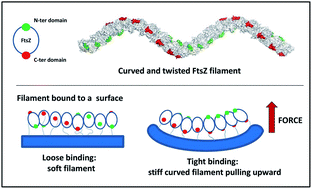Torsion and curvature of FtsZ filaments†
Abstract
FtsZ filaments participate in bacterial cell division, but it is still not clear how their dynamic polymerization and shape exert force on the underlying membrane. We present a theoretical description of individual filaments that incorporates information from molecular dynamic simulations. The structure of the crystallized Methanococcus jannaschii FtsZ dimer was used to model a FtsZ pentamer that showed a curvature and a twist. The estimated bending and torsion angles between monomers and their fluctuations were included in the theoretical description. The MD data also permitted positioning the curvature with respect to the protein coordinates and allowed us to explore the effect of the relative orientation of the preferred curvature with respect to the surface plane. We find that maximum tension is attained when filaments are firmly attached and oriented with their curvature perpendicular to the surface and that the twist serves as a valve to release or to tighten the tension exerted by the curved filaments on the membrane. The theoretical model also shows that the presence of torsion can explain the shape distribution of short filaments observed by Atomic Force Microscopy in previously published experiments. New experiments with FtsZ covalently attached to lipid membranes show that the filament on-plane curvature depends on lipid head charge, confirming the predicted monomer orientation effects. This new model underlines the fact that the combination of the three elements, filament curvature, twist and the strength and orientation of its surface attachment, can modulate the force exerted on the membrane during cell division.


 Please wait while we load your content...
Please wait while we load your content...